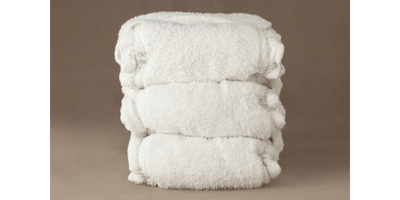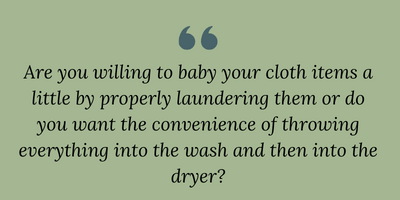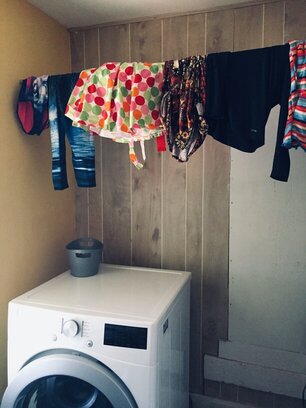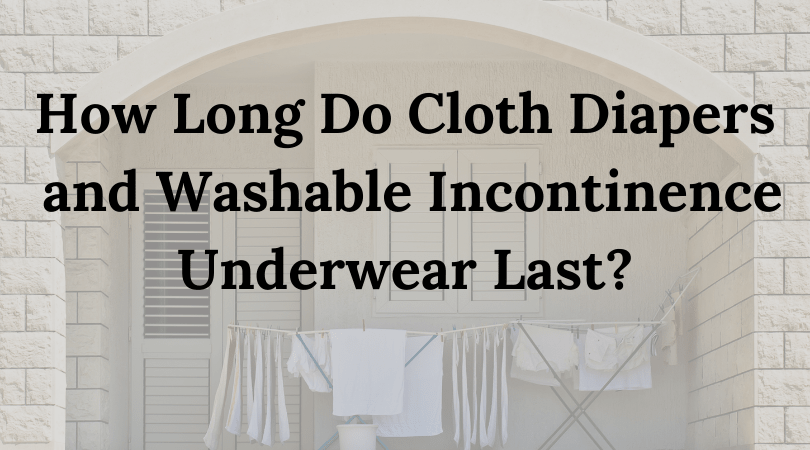How long do cloth diapers and washable cloth incontinence underwear last?
This is the magic question, right?
After all, those babies are waaaay more expensive than disposables and if you’re going to make the effort to use cloth, you’d probably like to know if the expense upfront is going to be worth it.
How long your incontinence items will last depends on several factors.
- How often you wear a single pair.
- How you launder them.
- Everyday wear.
- What material they are made from.
- The workmanship.
While you can expect your cloth incontinence items to last at least a year with regular use, don’t expect them to last forever. In the baby cloth diaper world, with proper care and number of diapers, cloth diapers generally last for the duration of 1 child and into the second.
As for a company’s own expectation for how long their product will last – their answers are ALL over the board.
One company that sells organic cloth incontinence pads estimate that their pads will last 150 wears. When I asked how they got that number, they said it was the average based on their tests.
But then again, another company selling incontinence underwear for men and women says a person can reasonably expect one of their items to last for about 52 wears.
Then another says their products can last up to 10 years if properly cared for….
Well. That’s helpful.
Anyway, These are the factors that go into determining how long washable cloth incontinence products will last.
1. How Many Cloth Incontinence Items You Have
Let’s just take a step back for a moment and be realistic here. Clothes wear out the more you wear them.
It’s an inescapable fact of nature. If you only have 5 t-shirts in your drawer and you wear them once, maybe twice a week, those t-shirts are not going to last 5 years.
This is true of cloth incontinence items too. The more you wear them, the faster they wear out. If you wear an item twice a week, it will wear out faster than if you wore it once a week.

Stash size matters.
– The more cloth incontinence items you have.
– The less frequently you wear and wash them.
– The longer you will have them.
I know, I know, those suckers are expensive and you may not be able to afford to go out and buy 10 incontinence items all at once.
You may only be able to afford to buy enough items for a 2 day rotation. And that’s okay.
Just don’t expect your cloth diapers and incontinence underwear to last you 2-3 years. If we go with the 150 wears thing, you could expect a 2 day rotation to last 300 days or roughly 10 months.
I know that doesn’t sound like a lot, but just think about it. (Cloth needs to be changed more frequently to avoid leaks and chafing, so I added an extra cloth item).
Cloth
2 day rotation (3 items/day) = 6 items
6 items at $35 each = $210
300 day cost = $210
Disposables
2 disposables (1 day) at $.85 ea = $1.70
$1.70 x 300 days = $510
Obviously, these numbers are estimations, since the actual cost of disposables and cloth are all over the board.
Another thing you could do is to calculate the cost per wear, if you’re still uncertain. Many places will give an estimated number of wears for an item.
Wears per product
Cloth product cost: $33
Last time: 52 wears
Cost per wear: $0.63
Still cheaper than a disposable and a lot more comfortable 🙂 Not to mention that’s 51 less things in the landfill.
2. How You Wash Your Cloth Incontinence Items
This conundrum is like the whole “do you want budget friendly or do you want convenience?” question of choosing a type of cloth incontinence item.
Flat and prefolds are the cheapest, but also require the most work. Cloth pads are also cheap, but may not effectively manage your level of incontinence.

The same goes with caring for your cloth diapers and leakproof underwear.
Are you willing to baby your cloth items a little by properly laundering them or do you want the convenience of throwing everything into the wash and then into the dryer?
If you baby your diaper covers or incontinence underwear by line drying them instead of throwing them in the dryer on high heat, they will last longer.
High heat makes things wear out faster. I know, it also makes things dry faster, which is nice if you have an absorbent diaper that takes forever to dry.
Line Drying
But between you and me, let’s just be honest. Taking a moment to line dry your more delicate, uh, unmentionables, (I couldn’t resist using that word as soon as it popped into my head, haha!), is simply a matter of habit, not an inconvenience.
The key is to make it easy and obvious.
For example, I like to line dry some of my daughter’s dresses and any items made from soft knits in order to avoid that annoying pilling knits like to do. Right now, our laundry room is shoved in a tiny, oddly shaped space and I often found myself piling wet items on the dryer and forgetting to take them upstairs to the bathroom so I could throw them over the shower rod to dry.
Result? Stinky damp clothes 2 days later.

Then, I had the ingenious idea of putting up a random suspension rod above the dryer and now line drying those items is a simple 2 second maneuver.
Obvious and easy, baby!
Also, don’t leave your diapers in a wet diaper pail!
Bacteria love a warm, wet environment. When my daughter was a baby, she had a blow out and I put her onesie in a plastic bag, tied it, and left it in the car for a week. You’d think we would have gotten the hint earlier due to the smell… When I found it, it was covered in black moldy spots. Ugh.
One thing they don’t tell you when you become a parent is that your gross factor threshold goes waaaay up.
Anyhow, even if your diapers get a little moldy and you are able to wash them clean, the damage is already done at a microscopic level. If you notice your cloth incontinence items seem to get a bunch of tiny pin sized holes – that’s damage from bacteria due to poor wash routine.
Make sure you store your dirty items in a dry pail with plenty of ventilation and wash items for moderate to heavy incontinence every 2 days.
3. Everyday Wear
If I’m honest, this one never crossed my mind as far as affecting the longevity of a cloth incontinence product. However, when I was questioning Zorbies on their longevity claims, they said that wear and tear has more to do with actually wearing than it does with machine cycles.
When the fabric of your incontinence item rubs against a stiff pant material like jeans or just the pressure from sitting, it can damage the fabric. While I’m not sold on this point of view, it certainly has merits for consideration.
4. What Material Your Diapers Are Made From
When it comes down to it, there are two types of fabric: natural and synthetic. Each of these fabric types requires different laundering techniques.
For an in-depth look, check out my post, How to Wash Different Cloth Diaper Fabrics.
One fabric that I don’t cover in that post is the knit fabric that leakproof underwear are made from. This could be cotton, polyester, nylon, rayon, etc. Most companies recommend washing on cold in a delicate or medium spin cycle and line drying. Or you could hand wash and line dry.
Different fabrics require different care in order to ensure they can live a nice, long life.
In addition, the higher the content of natural fibers, the better. Microfiber is king when it comes to quick absorption, but has a notoriously short lifespan. If you use pocket diapers, chances are, you will need to replace your inserts long before you need to replace the shell.
5. The Workmanship.
The actual impact of this may not be as great as the wear and tear of washing and wearing, but it’s worth considering. While price point – or country of origin – doesn’t necessarily indicate whether something is of quality or not, the sturdiness of the fabric and stitching go a long way in determining how long an item will last.
For example, stitches should be straight and flat with no loops or loose ends sticking up that can get snagged. Stitches should also be close together and when your item is stretched, you should see very little of the stitches.
In addition, the thickness of the fabric, and stretch factor are important. If you are using incontinence underwear, you want them to stretch to fit your body, but not become stretched out over time. Rib knits are particularly guilty of this.
Overall, most adult cloth diapers and leakproof underwear will last far beyond the initial investment when compared to the cost of disposables. Just how long they will last depends on your personal washing/wearing habit and to a smaller extent, the quality of fabric and workmanship.
Alecia
Latest posts by Alecia (see all)
- Best Adult Diaper Covers - March 7, 2024
- Best Fabrics for Making Adult Diaper Covers - February 16, 2024
- How to Use the Zigzag Stitch - May 4, 2023


